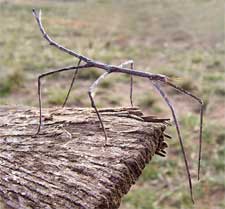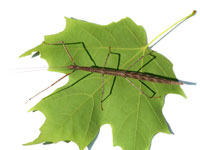|

 My pet stick: Unlike many insects, they make superb pets. Many species are very
low maintenance, requiring only blackberry leaves (or similar plant
species) and water. Stick-insects prefer to have their cages and
leaves misted with a spray bottle, although care must be taken not
to drown the fragile nymphs. Others do require heat or humidity
to be successful. A Walking Stick will usually live from one to
two years, depending on the species. My pet stick: Unlike many insects, they make superb pets. Many species are very
low maintenance, requiring only blackberry leaves (or similar plant
species) and water. Stick-insects prefer to have their cages and
leaves misted with a spray bottle, although care must be taken not
to drown the fragile nymphs. Others do require heat or humidity
to be successful. A Walking Stick will usually live from one to
two years, depending on the species.
No bones: Walking Sticks have exoskeletons, and instead of growing bones
until maturity they grow a new layer of skin beneath the old one,
shedding their old skin in the process. Females commonly molt 6
times, and males 5.
Playing dead & dancing sticks: Sometimes when Walking Sticks are disturbed, they will lay motionless
for hours. They will usually stop playing dead and perk up at nighttime
when they do most of their feeding anyway. Another reaction to being
disturbed is a swaying movement evolved to mimic sticks or leaves
blowing in the wind. And if a gentle breeze is applied, many species
will begin to feed. It makes them feel more comfortable about moving.
Many species begin to "dance" from the vibrations of footsteps,
etc. It has even been claimed that music can cause some Walking
Sticks to move this way (probably resulting from vibration).
Gentle sticks, scary sticks: While most stick-insects are gentle, there are species that can
be downright aggressive. One of the most popularly kept is Eurycantha
calcarata. Males of this species are commonly kept separately, and
rarely with other stick bug species, as they can be very cannibalistic.
They have large spikes on their hind-most set of legs, and do not
hesitate to swing them down abruptly. most popularly kept is Eurycantha
calcarata. Males of this species are commonly kept separately, and
rarely with other stick bug species, as they can be very cannibalistic.
They have large spikes on their hind-most set of legs, and do not
hesitate to swing them down abruptly.
Spraying sticks: When threatened, some species can emit a chemical spray which is
irritable to would-be predators. In certain species, this spray
can cause temporary blindness and considerable pain. Another species
releases an unpleasant odor when held.

Walking Sticks commonly lay their eggs in the soil, or on the underside
of available leaves. Some species are also parthenogenic, meaning
that the male does not need to fertilize the eggs, although fertilization
appears to increase the likelihood of the eggs to hatch healthy
young.
All text is available under the terms
of the GNU Free Documentation License
|